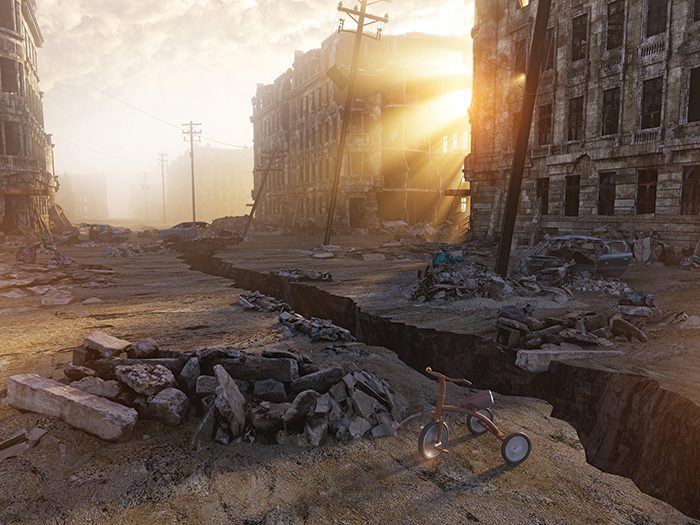Catastrophe Risk
California Earthquake Insurer’s Retrofit Plan Will Strengthen Buildings and Reduce Premiums

The California Earthquake Authority (CEA) is set to publish a document incorporating the latest risk modeling for retrofitting the most vulnerable types of structures to gird them against quake damage.
“We are creating this document as a pre-standard,” said Janiele Maffei, chief mitigation officer for CEA. “It is written in building-code language with the intent to have it adopted across the country.”
Los Angeles, San Francisco, Portland, Vancouver and Anchorage are all on or near the “Ring of Fire,” a girdle of subduction zones around the Pacific Ocean where some crustal plates are being driven under others. That causes volcanoes and earthquakes.
All of those cities, and dozens more, face similar hazards but address them in different ways. Los Angeles and San Francisco have mandated retrofits. Local reports in the Seattle area detail how similar efforts have gotten bogged down in socio-economic, tax and land-use issues.
Maiclaire Bolton-Smith, seismologist and senior leader of research for CoreLogic, explained there are areas of the Oregon and Washington coasts that have a very high earthquake hazard but have relatively low risk, because they are essentially wild lands with few structures or population.
Seismic retrofitting is adding structural reinforcement to buildings to make them better able to withstand earthquakes. It has emerged as economical and effective risk mitigation, especially for older homes and other small structures that were built to code decades ago but would not be compliant if built today.
The most vulnerable type of structure throughout California is one with a ‘soft story,’ a garage or retail space on the ground floor and living or office space above. The grim toll of the 1994 Northridge Quake and the 1989 Loma Prieta Quake graphically demonstrated that those open, unsupported soft stories collapse easily.
The second type of vulnerable structure in California is the hillside or hilltop home. The third, which is most common in the Los Angles area, is the ‘cripple wall,’ the short vertical box, usually made of wood, that encloses a crawl space under the first floor.
“The low-hanging fruit is the cripple wall,” said Maffei. “In an earthquake, those tend to topple and the house slides off its foundation. Often that results in a total loss for insurance purposes, because even if the rest of the house is not badly damaged, it still has to be lifted back onto the foundation and then repaired and reconnected.”
That can take months, during which loss-of-use coverage is in effect.
Using Data from Updated Quake Models
Maffei explained that building codes from the late ’70s added bolt-and-brace rules for all new cripple walls but did not mandate retrofitting. Since its inception, CEA has offered a five percent discount to homeowners that make seismic retrofits, which homeowners verify themselves. Under the authority’s annual rate and form filing for 2019, it has sought to replace that discount with a 15 to 20 percent discount for retrofits done and verified by certified contractors.
“Walking around San Francisco, it is easy to see the enormity of the challenge with soft stories and hillside structures,” said Andrew O’Donnell, senior engineer at risk-modeling firm AIR Worldwide. “My job as a researcher and our job as risk modellers is to allow our clients, like CEA, to draw their own conclusions based on the science and the engineering we present.”
He noted there is danger in the apparent lack of danger.
“The last major event was Northridge, more than 20 years ago. That means a whole generation of homeowners have never lived through a major event. The biggest challenge is risk communication. To them, it is abstract. To us, it is very real,” he said.
In July 2017, AIR released a new catastrophe risk model to be used by insurers and government agencies.
“It was the most comprehensive update ever,” said O’Donnell. It included detailed mapping of the Uniform California Earthquake Rupture Forecast and the most recent hazard maps from the U.S. Geological Survey (USGS).
“The last major event was Northridge, more than 20 years ago. That means a whole generation of homeowners have never lived through a major event. The biggest challenge is risk communication. To them, it is abstract. To us, it is very real.” — Andrew O’Donnell, senior engineer, AIR Worldwide
CEA is working with the Pacific Earthquake Engineering Research Center, which is affiliated with the University of California at Berkeley, to quantify how much reduction in damage there is with a result of brace-and-bolt retrofitting.
“We are doing materials testing and computer analysis to generate damage functions that we are going to give to our three risk-modeling partners, AIR, CoreLogic, and RMS,” said Maffei. We expect the reduction in premium could be more like 25 percent. That work started last year, and we expect to have results next year.”
In terms of retrofitting, “different local tectonic environments create different types of hazards. Hazards vary with setting,” said Keith Knudsen, deputy director of the USGS’s Earthquake Science Center. “It matters how far away the earthquake is, what type and magnitude it is, what type of construction and foundation a structure has, and what type of soil and rock are under the foundation.”
Maffei noted new data for the models, including age, number of stories, and whether there is a basement or crawl space, was not readily available from carriers writing traditional homeowner policies, because the primary concern was fire, not earthquake.
It is important to remember in all of this that “we are getting better at building,” said Bolton-Smith.
“Year on year, codes get better. Every six years or so the USGS issues new seismic hazard maps. We transform those hazard maps into risk vulnerability models.
“The insurance and reinsurance sector can take our risk modeling into consideration as they make their capital allocations of reserves against claims and also in their underwriting and pricing,” she said. “The key is being able to apply the data coming from the USGS and other sources.”
Science Informs Policy Crafting
“We participate in and inform policy discussions, but we don’t make policy,” said Knudsen. “We help policy organizations understand hazards and help engineers and regulators mitigate hazards.”
California has long mandated that underwriters offer earthquake coverage with homeowner policies. After massive losses in the wake of the 1994 Northridge Quake, premiums increased tenfold, and insurers were going to leave California, so Sacramento created CEA as a “public instrumentality of the state.”
That quake, magnitude 6.7, killed 57 people and injured thousands. It damaged 112,000 structures and caused more than $20 billion in property losses. More than 20,000 people were displaced.
CEA is the primary insurer for the earthquake cover that becomes part of retail homeowners policies offered by more than two dozen commercial carriers, which act as managing agents and collect premiums on behalf of CEA. The authority holds the risk. The commercial carriers assess claims and CEA makes payments.
As with any major underwriter, CEA makes extensive use of the reinsurance market. It would prefer to use those funds to broaden coverage. “We are working on legislation to reduce our payments for reinsurance,” said Maffei, “and to change our structure to post-event funding. That could free as much as $50 million, double our current fund and ten-times our current annual outlay.”
CEA has a loss-mitigation fund from which can be spent as much as five percent of the investment income, or $5 million, whichever is less. Since inception at the end of 1996, CEA has written about a million policies. It has a grant program that provides $3,000 toward retrofits through a lottery program that has focused on the areas of highest risk and vulnerability. About 5,700 retrofits have been completed.
Cost and Availability of Retrofit Programs
For a simple bolt-only retrofit in the Los Angeles area, the grant could pay for the whole project. Full bolt and brace could be $4,500. In the San Francisco area, bolt-only runs about $4,000 to $5,000; bolt and brace $5,000 to $7,000. CEA maintains a list of authorized contractors in an effort to prevent fraud and corruption.
“There is no such thing as earthquake-proof,” cautioned Maffei. “But we can significantly reduce the risk of houses sliding off their foundations.”
In 2015, the Los Angeles Department of Buildings and Safety (LADBS) adopted ordinances requiring the retrofit of pre-1978 wood-frame soft-story buildings and non-ductile concrete buildings.
As of August 1, LADBS has identified about 12,800 buildings that qualify for the soft-story retrofit program.
Property owners have a fixed amount of time to comply: Two years to submit proof of previous retrofit or plans to retrofit or demolish; three and half years to obtain a permit to start construction or demolition; and seven years to complete the work.
Of those 12,800 structures, only 44 percent comply with the two-year time limit for submitting plans for retrofit, just 19 percent comply with the 3.5-year time limit to obtain permits. A mere 8 percent comply with the seven-year time limit for completion.
The non-ductile concrete retrofit program applies to vulnerable buildings with a roof and/or floor supported by a concrete wall or concrete column, constructed before January 13, 1977.
Owners of those buildings have three years to submit a completed checklist for review; 10 years to submit proof of previous retrofit or plans to retrofit or plans to demolish the building; and 25 years to complete work. LADBS is still in the process of identifying the concrete buildings subject to the ordinance.
The bureau estimates the cost to retrofit apartment buildings with more than three units is up to $8,000 per unit. Notably, the ordinance does not apply to single-family homes.
There is no estimate for commercial buildings. Property owners can contact the California Capital Access Program on the California State Treasurer’s website for information about financial assistance programs.
Knudsen at USGS noted that this is the 150th anniversary of the last major quake on the Hayward Fault, which runs roughly parallel to the California coast from east of San Jose up through Oakland and Berkeley.
Regardless of quiescence for a century and a half, or just a generation, “people need to find out about the buildings they live and work in,” he said. “People need to ask if the building is safe.” &












